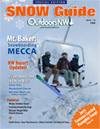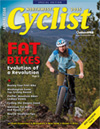NW Mountaineering Icons
Reflections from the world’s greatest climbers
By Shelley Seale
Legendary Climbers Dave Hahn and Ed Viesturs on Mount Everest
Mount Rainier rises majestically from the surrounding landscape, its imposing white summit jutting 14,410 feet into the sky. The glaciated volcano is known to many climbing enthusiasts as simply “The Mountain.” Only 65 percent of those who attempt Rainier each year succeed, yet its allure has been calling them for decades.
The naturalist John Muir apparently couldn’t help himself when he encountered the giant. In 1888 he wrote, “I did not mean to climb it, but got excited and soon was on top.”
Rainier, along with Mount Hood, Mount Adams and Mount St. Helens, offer limitless mountaineering possibilities to both beginning and experienced climbers, and have presented an irresistible lure for adventure junkies from around the world.

Lowell Skoog
“I think climbers benefit from the complex mountain environment we have here in the Northwest,” says Lowell Skoog, ski historian and founder of the Northwest Mountaineering Journal. “The weather is complex and challenging. The peaks are geologically complex, so you have to deal with a lot of different types of rock. Some of our approaches are long and rugged, so you learn to travel efficiently carrying climbing and bivouac gear. For me, complexity is the key advantage of Northwest mountains for an aspiring climber.”
Jim Whittaker, who became the first American to summit Everest in 1963, started out as a guide on Mount Rainier and is eloquent about the appeal of mountaineering.
“It is in the wild places — in the damp, clean air of an ancient forest, on a snowy summit at the top of the world — that I enter my own personal cathedral and know where I fit in the vastness of creation,” he says.
Many notable climbers express similar feelings, including Whittaker’s nephew Peter, who first climbed Rainier when he was 12 years old and has since made more than 200 ascents of the mountain.

Peter Whittaker
“I grew up with an uncle and a father (Lou Whittaker) who were larger than life — they were living legends,” Peter Whittaker explains. “I wasn’t asked if I was going to climb mountains. My father pretty much just tied a rope around me and hauled me up.”
In response to the expectations, initially Whittaker shunned climbing in favor of skiing. “It made a lot more sense to me to ride up the mountain in a chair lift and then ski down.” As a young adult he began guiding in his father’s company, Rainier Mountaineering, Inc., as a convenient summer job and finally discovered a love of climbing on his own.
Like his father and uncle before him — twin brothers who turned 80 this year — Peter Whittaker found himself on Everest, on a 1984 expedition with his father. For a while, Whittaker took people on climbs all over the world through a company he started, Summits Adventure Travel. “I enjoyed helping them attain their goals,” he says. It was on one of these trips that he met his wife, and their subsequent family life led to Whittaker shifting his attention closer to home.
He returned to the family business, RMI, and assumed a lead role. “Now that I had children, I didn’t want to be gone so much. I focused on what was in my own backyard, and that was Rainier. It has all the features of a Himalayan peak, and is the toughest endurance climb in the lower 48.”
It is exactly these characteristics that draw serious climbers to train there, and why so many top names in American mountaineers hail from the Pacific Northwest. Jim Whittaker’s 1963 Everest team trained on Rainier, attempting and failing a summit bid three separate times; yet they went on to ultimately stand on top of the highest mountain in the world.
Lou and Jim Whittaker
Peter Whittaker is quick to point out that the Central Cascades are also a great place for a beginner to learn mountaineering; he estimates that 60 – 70 percent of RMI’s clients are first-timers. “I love taking people into our mountains for the first time, and showing them that world.”
His newest venture is RMI’s partnership with the new Eddie Bauer First Ascent line of expedition-quality mountaineering gear. It began three years ago when Neil Fiske, the new CEO of Eddie Bauer, was on Whittaker’s rope on a climb of Mount Rainier. Fiske talked about his company’s desire to re-establish its roots as a serious outfitter, and he wanted to put together a team of the top climbers in the world to develop the best gear on the market.”
I was a little skeptical at first,” Whittaker admits. “But what Neil was proposing was unique. He didn’t just want us to test the gear, he wanted our total involvement in creating and developing it.”
Dave Hahn
He worked alongside colleagues Ed Viesturs and Dave Hahn, two other Seattle-area legendary climbers, to create gear with total functionality above over-constructed design and what Whittaker calls unnecessary bells and whistles. When he talks about the new line, he’s clearly proud of it.
“We live in this gear on Rainier, and in the Himalaya and Ecuador. We really hammer on it and try to tear it apart. It’s very authentic,” he says. “As mountain guides, people hire us to make life and death decisions, and we take that very seriously.”
Ed Viesturs
One of Peter Whittaker’s fellow guides at RMI, Viesturs is one of America’s most famous climbers. To those outside the mountaineering community, Viesturs is perhaps best known for being on the IMAX team filming on Mount Everest when the 1996 disaster happened, as chronicled in Jon Krakauer’s book Into Thin Air. Viesturs’ team decided to turn back from the summit that fateful day because of weather conditions. For others who proceeded forward, the death toll would eventually be eight, including Viesturs’ good friends Rob Hall and Scott Fischer.
Viesturs is known for his focus on safety and an often cautious approach. “For me, how I reach the top is more important than whether I do,” he says. “Reaching the summit is optional. Getting down is mandatory.”
Today he spends a lot of time guiding primarily beginning alpinists on Rainier. “They may have hiked some mountains or climbed smaller peaks, but for the most part it’s their first time putting on crampons and using ice axes and harnesses,” says Viesturs. “When we do some of the more lengthy seminars, such as the six-day treks on Rainier, then it’s people who may have already climbed Rainier with us on a two-day ascent and want a bigger challenge.”
Ed Viesturs
Viesturs loves the Northwest because of this wide range of opportunities it provides. “In the whole Cascades range, you have the simpler glacier ascents on some of the smaller volcanoes, and then you’ve got the whole gamut in the North Cascades where approaches are one- to two-day events. There’s a huge variety, from the stuff that novices can do to the other end of it, where alpinists can have some really hard and amazing climbs.
There’s a lot of places here you can climb just on the weekend — they’re great stepping stones to gain the experience. You can do whatever you want right here and never have to leave.”
Viesturs enjoys the teamwork and camaraderie of longer-term expeditions from one to six weeks, but admits to feeling the reward of showing newbies his world for the first time.
“The big thrill I get is seeing them as they’re experiencing something brand-new, seeing sights they’ve never seen and getting challenged in ways that they never have before. They come away and say, ‘Wow, that completely changed my life,’ because their attitudes about themselves are different, and what they feel they are capable of doing.”
Viesturs is very familiar with the personal life-changing moments that the mountains bring, and climbers’challenges to go bigger and more often. His latest quest was a goal to climb all 14 of the world’s highest mountains without supplemental oxygen, and he is clearly a man who doesn’t give up easily.
“It took 18 years, and that’s a long investment to do one project. The highlight was when I climbed the last mountain, which was Annapurna,” he recalls, talking about a peak that claims the life of one climber for every two who reach its summit. “That was an amazing moment, because to struggle through something for 18 years — to have your ups and downs and not give up — I was pretty proud of that. Sitting on the top of that last mountain was literally a dream come true.”
It’s a dream he shares in the book inspired by his journey, No Shortcuts To The Top: Climbing the World’s 14 Highest Peaks. The triumphant memoir follows his assault on the mountains as well as history; but perhaps more telling, he reveals a man torn between the majestic, but deadly, places he climbs and the flat, safe world he shares with his loved ones. Clearly, if the definition of passion is something you can’t not do, climbing is the defining passion of Ed Viesturs’ life.
“Climbing is my hobby, my business and my life,” he says. “Everything that I do is related to climbing.”
Stacy Allison
Mountains are not there for us to conquer, believes avid mountaineer and Portland resident Stacy Allison. “If you see yourself as trying to beat the mountain, eventually the mountain will win. You don’t conquer mountains, you cooperate with them.”
That truth was evident during Allison’s first attempt at Everest, in 1987. The worst storm in 40 years trapped her and her teammates in a snow cave at 23,500 feet for five days, robbing them of any opportunity to summit that was remotely safe, or even possible. “Turning back can be the most important yet difficult decision of all, particularly when there is so much pressure to succeed,” Allison reflects. This desire to defeat the mountain at all costs, the all-consuming feeling that summiting is the only acceptable outcome, has led to many of the disasters and deaths on peaks such as Everest, K2 — even Rainier, where two or three climbers are lost each year.
Stacy Allison
Allison returned to Mount Everest the following year and after 29 days, she finally reached the top of the world, becoming the first American woman to do so. What followed afterward was a flurry of media attention that Allison seems to have cared little about. The first night she was back in the U.S. she received a call from the David Letterman show; she also appeared on Good Morning America and in a feature story in the New York Times.
“It was a lot of fun,” she says, “But quite frankly, that’s not why I climb and it’s not what I’m interested in.” Her ccomplishment and resulting publicity, instead, caused Allison to turn inward and do some soul-searching about her life’s purpose.
“I had to take a good, hard look at myself, at my values and how I interact in the world. I can’t get up there and talk to people, or be a role model for young people, if I’m not doing the right thing in my everyday life.”
Being the object of admiration, a role model, is a responsibility that Allison takes very seriously. “It’s important for people to have someone they can believe in, and not be disappointed. It’s about giving back.”
Allison wrote a book about her experience, called Beyond The Limits: A Woman’s Triumph on Everest; and soon followed it up with a second, which related the lessons she’d learned from her climbing challenges to everyday life.
In Many Mountains to Climb: Reflections on Competence, Courage and Commitment she tries to inspire people to reach beyond their limitations, and moved into her current role of motivational speaking and training for companies and organizations.”
The mountains really offer many arenas for lessons in teamwork and leadership. When I’m up on the platform speaking, even though the stories are about my experience, it’s not about me. It’s about the audience. Change, perseverance and risk-taking are things we can all relate to.”
The most rewarding thing Allison gets from her mountaineering life is the ability to share the outdoors with her children now, as well as the people she takes on climbs through her volunteer work with Medical Teams International and The Oregon Lung Association’s fundraiser, Reach the Summit. “Most of the people who participate have never climbed before. Many of them have never even hiked in their lives. The transformation that can take place in people — the self-confidence, the appreciation for their natural environment — is truly exceptional to watch and be a part of.”
Resources:
Eddie Bauer First Ascent: www.eddiebauer.com
Ed Viesturs: www.edviesturs.com
Northwest Mountaineering Journal: www.mountaineers.org/nwmj
Stacy Allison: www.beyondthelimits.com
The Mountaineers: www.mountaineers.org
NW Guiding companies:
American Alpine Institute: www.aai.cc/
International Mountain Guides: www.mountainguides.com
Mountain Madness: www.mountainmadness.com
Mountain Link: http://mountain-link.com/
NW Mountain Guides: www.mountainschool.com
Northwest Mountain School: www.mountainschool.com
Rainier Mountaineering, Inc. (RMI): www.rmiguides.com
Shelley Seale is a freelance writer and written for National Geographic, The Seattle Times and Washington Magazine, among others. She can be reached at shelleyseale.com.



